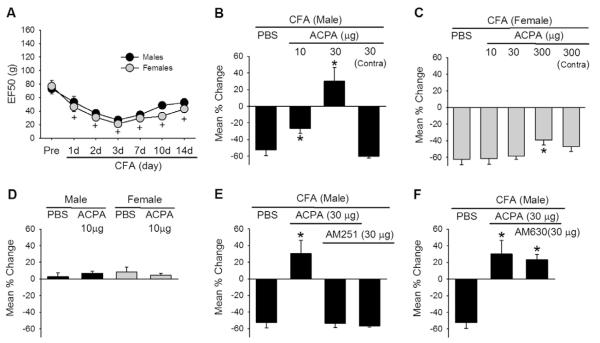Fig. 1.
Effects of arachidonylcyclopropylamide (ACPA) on complete Freund’s adjuvant (CFA)-induced mechanical hypersensitivity. (A) CFA-induced mechanical hypersensitivity measured in the masseter muscle of male and normally cycling female rats. Mechanical force (g) that produced the head withdrawal responses 50% of the trials is plotted for pre- and 1, 2, 3, 7, 10, and 14 days post-CFA injection. +denotes significant time effects at P < 0.05 compared to the pre-CFA values. (B, C) Effects of intramuscular ACPA on mechanical sensitivity 3 days after CFA treatment in male and female rats. Bar graphs show mean % change in EF50 values in vehicle (phosphate-buffered saline [PBS])- and ACPA-treated rats. *denotes significant differences at P < 0.05 compared to the vehicle group. Contra-ACPA injected in the masseter muscle contralateral to the mechanical sensitivity testing. (D). Effects of ACPA on mechanical sensitivity of naïve male and female rats. (E, F). Effects of a CB1R antagonist (AM251) and a CB2R antagonist (AM630) on ACPA-mediated antihyperalgesic responses 3 days after CFA treatment in male rats. *denotes significant differences at P < 0.05 compared to the vehicle group. All data are shown as mean ± SE and each group consisted of 6–7 animals.

